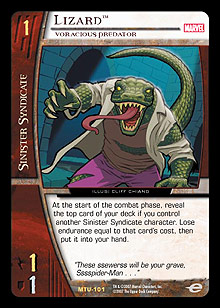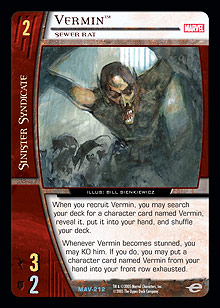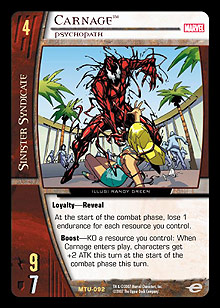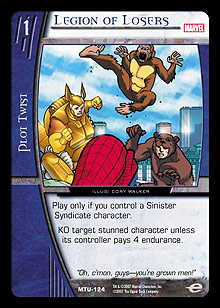There are certain things that we all love about Vs. System. For some, it’s playing at a highly competitive tournament level. For others, it’s the ability to play a fun card game with friends. And for even more, it’s just the chance to sit down and flip over a piece of thinly sliced cardboard with an awesome picture of Spider-Man on it. I am pretty much all three of those things rolled into one. While I love to play at a highly competitive level, I still try to choose decks that allow me to play with my favorite characters.
Specifically, I remember always having an affinity for the Syndicate. For whatever reason, I really liked Tombstone. Having a 3 ATK / 4 DEF 1-drop is awesome. Unfortunately, his drawback was really just too burdensome to make the deck even somewhat competitive. I went ahead and built up a Sinister Syndicate rush deck, relying on early drops and Goblin Glider, but something didn’t feel right about it. As much as I loved the characters, I felt like I was missing something.
Enter Marvel Team-Up
Given my interest in the Syndicate, it is easy to understand how much I was looking forward to Marvel Team-Up. There had been a couple of cards previewed that really piqued my interest, like Answer, Aaron Nicholson. Immediately, my mind started racing with ways to improve my long-forgotten deck idea.
When I finished my Sneak Preview, my teammate John Hall and I sat down and looked at our cards. We had both managed to pull a copy of Lizard, Voracious Predator, as well as copies of Answer, Aaron Nicholson, and Carnage, Psychopath. We could easily see a deck abusing those three cards. While I was thinking of Golden Age implications, however, John was eyeing a Silver Age deck idea. After some intense discussions, a few black eyes, and some apologies, I agreed that constructing a Silver Age deck would be a better idea (and honestly, more fun, because it would allow us to play with a ton of new cards).
Let’s Build a Deck!
The first task that we had in front of us was trying to come up with a goal for the deck. As I have said many times before, if you don’t know what your deck is trying to do, it will never be successful. It was pretty easy to establish that we wanted a
Faces of Evil /
The New Brotherhood type deck. The characters were large enough that we could honestly expect to end the game early, before the swarming strategy would become a liability.
 Considering that we were trying to build an off-curve deck, we knew that we would need to load up on 1- and 2-drops. Given that we had both pulled a copy of Lizard, Voracious Predator, we figured he would be a good starting point for the deck. The biggest problem that I had with my previous Syndicate deck was running out of cards, and Lizard can help that by giving you a free card every turn (as long as you control a Syndicate character). At first, John wasn’t too keen on including a character that causes its controller to lose endurance every turn, but you can reduce characters’ liabilities if you build a deck correctly. Playing four copies of Lizard just meant that we would have to play a lot of cards with a low threshold cost that could still provide a big benefit.
Considering that we were trying to build an off-curve deck, we knew that we would need to load up on 1- and 2-drops. Given that we had both pulled a copy of Lizard, Voracious Predator, we figured he would be a good starting point for the deck. The biggest problem that I had with my previous Syndicate deck was running out of cards, and Lizard can help that by giving you a free card every turn (as long as you control a Syndicate character). At first, John wasn’t too keen on including a character that causes its controller to lose endurance every turn, but you can reduce characters’ liabilities if you build a deck correctly. Playing four copies of Lizard just meant that we would have to play a lot of cards with a low threshold cost that could still provide a big benefit.
At this point we had a goal, and had set parameters for the deck construction. The rest seemed to flow rather easily after that. We looked back on legacy content to see if there were any 1-drop characters that would be Silver Age legal. Immediately, Basilisk came to mind. He has a big body (4 ATK) and a very beneficial ability (can keep problematic characters exhausted). The fact that he comes into play exhausted is a drawback, which is why only two copies are included in the deck.
After Basilisk, we didn’t find any legacy characters that fit within what we were trying to accomplish, so we started looking at the new stuff. Fusion was a really interesting character because he had decent stats, could fix your row with his reservist keyword, and a pertinent power. Toward the end of the game, the ability to KO a resource to draw a card is a strong play—especially if you manage to draw into a new threat like a power-up or a plot twist. There are also characters available to the Syndicate that cause endurance loss to you equal to the number of resources you control, so the ability to limit that loss is really strong.
Slyde seemed like another logical choice for the deck. He has the exact same stats as Fusion and is also a reservist, but his power appeared to be more relevant. One of the biggest problems that a player may be confronted with is the need to stun a problematic hidden character. Cards like Surveillance Pawn, Terry Sloane ◊ Mr. Terrific, or Ahmed Samsarra need to be dealt with in order to throw your opponents off their game plans, and Slyde can easily do that for you.
Last but certainly not least was Vulture, Aerial Stalker. He has a big body, like Basilisk, but does not enter play exhausted. Unfortunately, the fact that he has loyalty really precludes him from being usable as a 1-drop. Vulture, Aerial Stalker is really more of a 2-drop, but turns 3 and beyond are where he really shines as a solid underdrop option.
 At this point, we felt that the 1-drops were adequately covered, so we moved on to the 2-drops. We still hadn’t found that lynchpin character that would make the deck go, so we were a little concerned. Again, we decided to look at legacy content to see if there was anything that could benefit the deck. It was at this point that we both realized an amazing thing: Vermin, Sewer Rat is broken. Let me repeat that so you can either laugh at me or really let it sink in: Vermin, Sewer Rat is broken. The biggest issue that faces off-curve decks today is maintaining their field presence. Vermin can fix that not only by providing field presence, but also by giving you hand advantage with a potential power-up. Immediately, we had found our lynchpin card.
At this point, we felt that the 1-drops were adequately covered, so we moved on to the 2-drops. We still hadn’t found that lynchpin character that would make the deck go, so we were a little concerned. Again, we decided to look at legacy content to see if there was anything that could benefit the deck. It was at this point that we both realized an amazing thing: Vermin, Sewer Rat is broken. Let me repeat that so you can either laugh at me or really let it sink in: Vermin, Sewer Rat is broken. The biggest issue that faces off-curve decks today is maintaining their field presence. Vermin can fix that not only by providing field presence, but also by giving you hand advantage with a potential power-up. Immediately, we had found our lynchpin card.
Now that we had our preferred 2-drop, all that was left was to fill in the gaps. There really wasn’t anymore legacy content that struck our fancy, so we moved on to the new stuff. As I stated earlier, Answer had really caught my eye, so he was an easy inclusion. Having a 2-drop that can take down the biggest character—albeit at a cost—was still a really good inclusion. In this deck, you really don’t care too much about your endurance as long as you are bringing your opponent down faster, so I didn’t feel that his drawback was enough to keep him out of the deck.
Spider-Slayer V.X. is another one of those characters that burn you at the start of your combat phase. However, his boost can help prevent this damage, in addition to giving him the ATK of a 4-drop character for only 2 resource points.
The next character that we included wasn’t so obvious. Swarm actually seems to work against all the resource destruction. His stats depend on controlling resources, so if you are blowing them up he doesn’t seem like a great call. However, I tend to like him because he has flight and range. I wouldn’t really envision KO’ing resources until turn 4 or 5 at the very earliest, which means you can still get him up to 4 or 5 ATK for only 2 resource points.
Trapster works a lot like Basilisk, except that your opponent can prevent the exhaustion effect. If your opponent chooses to prevent it, you are still getting a beneficial impact through the 3 endurance that your opponent just lost. I like this guy as an aggressive, on-initiative play.
The last couple of 2-drop characters that were considered were Black Tarantula and Electro, Shock Jock. Tarantula was on the bubble for most of the deck’s construction because he doesn’t do much in terms of aggression. He provides the ability to cause stunbacks, however, which could be beneficial, so he made the cut. Electro was also on the bubble, mainly because you really wouldn’t want to play him on turn 2 or 3, since losing 3 endurance every time he defends could be a huge problem. I could see a situation where he could cost you upwards of 9 endurance in a game if you played him on turn 2. As such, he was included as a one-of to try and limit his liability.
With a ton of 1- and 2-drop characters, it was time to cap off the character curve. This was a fairly easy task, since Spider-Man Robot is one of the best finishers that you could ask for. His boost is a Blind Sided effect for your opponent’s entire field, much in the vein of Other-Earth. You never want to play Spider-Man Robot until your kill turn because he is a defensive nightmare. With only 1 DEF, anyone can take him down, so he really is a last-turn play.
 Carnage, Psychopath was the only character left that we needed to include. Much like the Spider-Man Robot, Carnage is most effectively used as a finisher. His boost is incredibly strong, but you need to keep in mind that it gives the ATK modifier to your opponent’s characters as well. These types of modifiers are easily overlooked, so you need to be sure that you fully understand them.
Carnage, Psychopath was the only character left that we needed to include. Much like the Spider-Man Robot, Carnage is most effectively used as a finisher. His boost is incredibly strong, but you need to keep in mind that it gives the ATK modifier to your opponent’s characters as well. These types of modifiers are easily overlooked, so you need to be sure that you fully understand them.
Once we had all the characters chosen, we started looking at the plot twist selection. As stated earlier, Lizard, Voracious Predator gave us some parameters to work with in terms of overall card selection, so we tried to select effective plot twists that had a low threshold cost.
Flying Kick, Trial by Fire, and No Fear were easy inclusions. All three cards provide a meaningful ATK modifier that can enable attacks up to two spots up the curve with only a 1 threshold cost each. These cards definitely fit within the parameters that we are trying to adhere to, and due to their low cost, they can also allow you to get hyper-aggressive really early.
The next three plot twists came out of the new set, because of their synergy with the characters. Legacy of Evil works well with all the underdropping and resource KO’ing that’s packed into the deck. The ability to refill your hand with threats that your opponents then have to deal with is a strong play, and should not be easily dismissed.
Likewise, Legion of Losers works well within the deck. If you can clear out a problematic character, the chances of maintaining your own field are increased, which in turn can be viewed as potential damage down the road. Your opponent can stop this from happening, but at the cost of losing 4 endurance immediately. Either way, you are in a good position, which is why this card is an easy inclusion in the deck.
The only plot twist that we haven’t covered is arguably the most powerful one in the deck. Spider Hunt is a The New Brotherhood effect to all of your characters. Again, you have to take into consideration that it costs a resource to play, but it is easy to play around once you get a couple of games under your belt.
Now that characters and plot twists were covered, we moved on to the last possible inclusions in the deck: equipment and locations. Hidden Cache was a bomb in John’s sealed deck at the Sneak Preview. A reusable pump that actually increases with every turn is a real nice effect. Remember that the deck is very focused upon the number of resources you control, so in order to effectively use this card, you need to be able to determine when it’s the right time to start KO’ing resources.
It’s funny that for the most part, John and I agreed on everything that we included in this deck. However, we disagreed with the last inclusion. He wanted to play Alien Symbiote, while I felt that Dual Sidearms would be a better call. I admit that the Symbiote would give you an extra point of ATK, but the rest of the card was just a huge liability. Since the entire deck is Sinister Syndicate, you don’t really care if it gives that affiliation or not. Also, considering there are so many characters that already burn you, I just didn’t think that the extra point of damage was worth it—especially when measured against the Sidearms, which make up for that extra point of ATK by giving the equipped character range. In the end, since it’s my article, I decided to go with Dual Sidearms. It’s good to be king, isn’t it?
The Finished Product
The Sinister 60
Characters
2 Basilisk, Basil Elks
2 Fusion, Markley
4 Lizard, Voracious Predator
2 Slyde, Jalome Beacher
2 Vulture, Aerial Stalker
 4 Vermin, Sewer Rat
4 Vermin, Sewer Rat
2 Answer, Aaron Nicholson
1 Black Tarantula, Carlos LaMuerto
1 Electro, Shock Jock
2 Spider-Slayer V.X.
2 Swarm, Fritz von Meyer
2 Trapster, Peter Petruski
3 Spider-Man Robot, Timespinner
3 Carnage, Psychopath
Plot Twists
4 Flying Kick
4 No Fear
4 Trial by Fire
4 Legacy of Evil
4 Legion of Losers
3 Spider Hunt
Equipment
2 Alien Symbiote, Unique
Locations
3 Hidden Cache
This deck has actually tested very strong. For the most part, you almost always want odd initiatives and to try to finish on turn 5. In terms of the preferred opening hand, you exclusively look for Vermin, Sewer Rat. I can’t really envision a hand where you would want to throw him away. He singlehandedly can keep you from being double stunned on your off initiatives, so having him early is very important. I can understand keeping a hand where you have a 1- and 2-drop along with a couple of supportive plot twists as well, but it’s been my experience in testing that you always want Vermin early.
Considering that this deck isn’t legal until Marvel Knights rotates out, it wasn’t really that effective to test against anything running Mikado and Mosha. One of the major reasons why this deck thrives is that it exists in a format where Mikado and Mosha isn’t around. As such, there were no real definitive testing results to give you. Still, I would encourage everyone who is looking for a fun deck that packs a punch to give this deck a try.
Shane Wiggans, one of the nicest guys with a tattoo sleeve, is also a member of Team Alternate Win Condition and couldn’t be more excited about the new Marvel Team-Up expansion. If you agree with him, or have any questions or comments, feel free to say hey at any event or email him at piercedlawyer@yahoo.com.